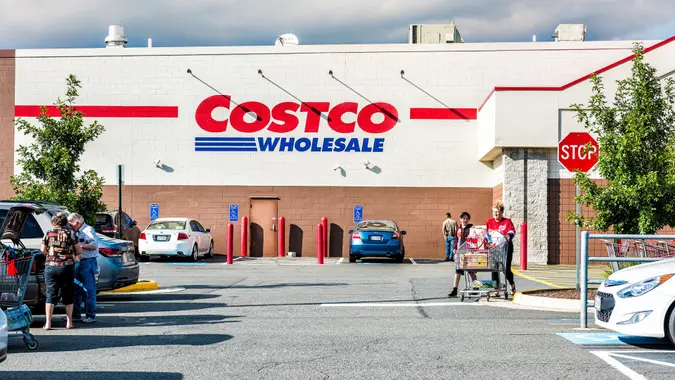What Gas Prices Could Look Like in 2025 If Trump Wins

Commitment to Our Readers
GOBankingRates' editorial team is committed to bringing you unbiased reviews and information. We use data-driven methodologies to evaluate financial products and services - our reviews and ratings are not influenced by advertisers. You can read more about our editorial guidelines and our products and services review methodology.

20 Years
Helping You Live Richer

Reviewed
by Experts

Trusted by
Millions of Readers
Nobody likes high gas prices. While presidential candidates like Donald Trump often cite a desire to reduce gas prices, the truth is that the U.S. president doesn’t have a ton of control over them. What this means is that, even if Trump ends up back in the Oval Office, there’s no guarantee that you’d end up paying more — or less — when filling up at the pump.
That said, the president could have an indirect impact on gas prices. Certain policies and new legislation could influence the cost of gasoline. Just know that prices are primarily based on oil prices, which are largely related to supply and demand.
These are the main factors that actually influence gas prices, and how Donald Trump may influence them if he’s elected again.
Domestic Production Could Increase
According to the U.S. Energy Information Administration, domestic petroleum refineries take crude oil (and similar liquids) and convert it into gasoline and other petroleum products. This crude oil is often imported from other countries, but many refineries use a combination of domestic and foreign oils.
The majority of gasoline sold in the U.S. comes from U.S. refineries. If Trump gets elected and introduces new policies to change the way gasoline — or the crude oils it comes from — is produced or obtained, it could impact the cost of production and what consumers pay at the pump.
“Donald Trump typically prefers strategies aimed at raising domestic production levels while reducing regulatory burdens on those firms that deal with fossil fuels,” said Chuck Warren, political economist and host of the Breaking Battlegrounds politics podcast. “His administration’s policies were more focused on energy independence and deregulation of the oil and gas industry.”
If Trump’s policies result in more domestic production, it could lead to lower gas prices.
Short- and Long-Term Impact on Gas Prices
Warren believes Trump’s potential policies could have a short- and long-term effect on gasoline prices.
In the short term, he said there could be an overall reduction in petroleum prices. This is due to two main factors:
- The increased production of oil domestically means greater supply (and can be more cost-effective than importing gasoline or the crude oils necessary to produce it).
- Deregulation could mean less restrictions on drilling, which could also enhance the current supply and reduce expenses for consumers. Since Trump has also had a history of supporting the fossil fuel industry, it could mean lower gas prices.
In the long term, Warren said, “Prices may stay low.”
However, this wouldn’t necessarily just be due to who’s in office. Other factors — like environmental factors and market volatility — can also affect gasoline prices. If oil prices go up on a global scale, it could affect domestic production (and costs).
According to the EIA, these are the other main factors that directly affect gasoline prices:
- Cost of crude oil (domestic production could lower this, depending on other factors like supply and demand)
- Taxes (federal, state and local)
- Cost of refining oil and profitability (vary by season and region)
- Marketing and distribution costs and profits (vary by factors like retail dealer costs, shipping costs, etc.)
History Speaks for Itself
Historically speaking, the U.S. president hasn’t been the main factor contributing to gasoline prices.
Back in early 2022 when Russia invaded Ukraine, oil prices skyrocketed due to concerns over supply. This isn’t too surprising considering Russia is one of the leading oil producers in the world. At that time, the price of gasoline was around $3.60 per gallon. Within about a week, prices had risen to over $4 a gallon. A couple of months later, they’d gone up to an average of $5 a gallon nationwide.
During this period, President Biden strived to get a handle on the situation. This included drawing a record amount of gasoline from the Strategic Petroleum Reserve (SPR). His administration did claim that they were able to keep prices from rising even more, but this is largely speculation.
This isn’t the only incident that gives weight to the concept that the U.S. president doesn’t have quite as much control over gasoline prices as people might think. Since 1993, gas prices have risen pretty consistently — with only a few notable drops. One of the biggest dips in gasoline prices occurred in the 2000s when the cost per gallon went from $4.11 in December 2008 to $1.75 in January 2009. This was during the 2008 financial crisis and the Great Recession, which hit the oil and gas sector, leading to falling revenues for these companies and significantly reduced prices.
As 2008 was an election year, one could argue that the presidential election had an impact on gasoline prices. But the main thing affecting these prices was the way the housing market crashed — something that was largely due to risky lending practices.
Bottom Line
As Warren pointed out, a Trump presidency could mean more focus on deregulation and prioritizing domestic gasoline production and refinement. This could then lead to lower prices both in the short- and long-term.
However, the long-term impact might not be as significant as it seems. This is because external factors — like taxation, production and distribution costs, supply and demand and even global factors — can all affect the overall cost of gasoline.
Along with this, gas prices continue to rise, seemingly regardless of who’s in office. As of July 2024, a gallon of fuel goes for $3.60 on average. While there was a dip in June 2022 (which is when prices reached their peak of $5 a gallon before declining), they’ve since been steadily on the rise.
Editor’s note on election coverage: GOBankingRates is nonpartisan and strives to cover all aspects of the economy objectively and present balanced reports on politically focused finance stories. You can find more coverage of this topic on GOBankingRates.com.
 Written by
Written by  Edited by
Edited by 

























